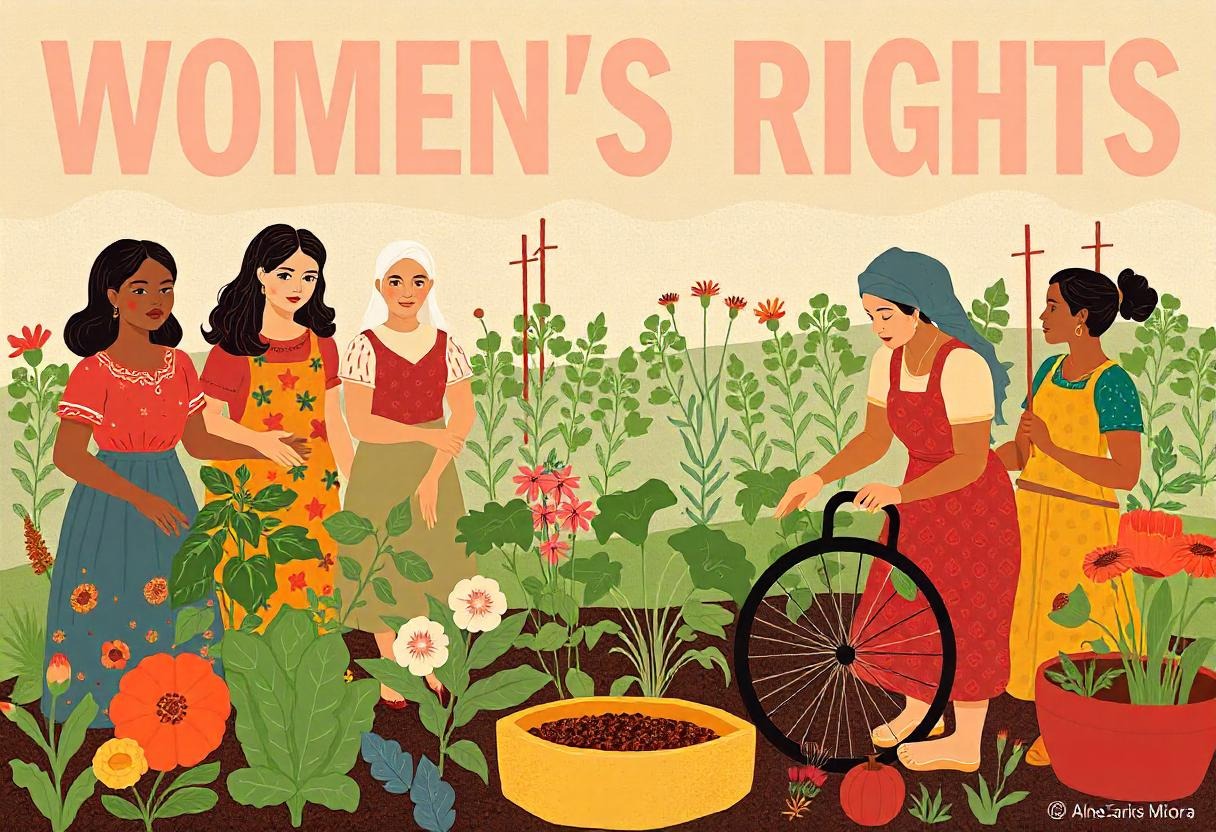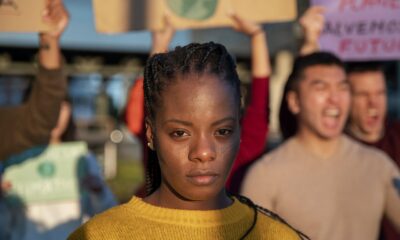HUMAN RIGHTS
Women’s Rights Poster: A Powerful Symbol of Equality

A women’s rights poster is more than just an image; it is a rallying cry, a powerful symbol of resistance, and a testament to the ongoing struggle for gender equality. From the suffragette movement to modern-day feminism, posters have played a crucial role in shaping public perception, sparking discussions, and mobilizing people for change.
Over the decades, these visual tools have evolved, reflecting the different phases of the feminist movement, addressing pressing issues such as voting rights, equal pay, reproductive rights, and the fight against gender-based violence. Whether displayed at protests, educational institutions, or digital platforms, these posters serve as a reminder that the fight for women’s rights is far from over.
In this article, we will explore the historical significance, design elements, and modern-day relevance of women’s rights posters, highlighting how they continue to inspire change across the world.
The Historical Impact of Women’s Rights Poster
Suffragette Movement and Early Feminist Posters
The women’s suffrage movement in the late 19th and early 20th centuries marked the beginning of large-scale feminist activism. Posters during this period were designed to rally support for women’s voting rights. They featured bold typography, patriotic imagery, and strong slogans like “Votes for Women!”
The Women’s Social and Political Union (WSPU) in the UK created one of the most iconic posters from this era. It depicted women in white dresses, symbolizing purity, while demanding their right to vote. Similarly, in the U.S., posters showing women holding ballots were widely distributed to raise awareness and encourage legislative action.
The Second Wave of Feminism: 1960s–1980s
The second wave of feminism, which focused on workplace rights, reproductive freedom, and legal equality, saw the rise of striking posters. Many of these posters featured bold colors, minimalist illustrations, and slogans like:
- “The Personal is Political”
- “Women’s Rights are Human Rights”
- “Equal Pay for Equal Work”
Artists like Corita Kent used vibrant graphics to capture the urgency of the movement, while activist groups like the National Organization for Women (NOW) distributed posters demanding legislative change.
Modern Feminist Posters: Digital Activism
With the rise of social media, women’s rights posters have taken on a digital form. Movements like #MeToo and #TimesUp have used online posters to raise awareness about sexual harassment and gender inequality. These modern posters are designed for rapid sharing, featuring strong messages and powerful imagery that resonate with global audiences.
Some recent impactful designs include:
- A black-and-white poster stating “Believe Women”
- An illustration of a raised fist with the words “Women Unite”
- Digital art advocating for reproductive rights with the slogan “My Body, My Choice”
The Role of Design in Women’s Rights Poster
Typography and Messaging
A compelling women’s rights poster relies on strong typography. The choice of font can convey emotion, urgency, or authority. For example:
- Bold, capitalized fonts create a sense of strength and defiance.
- Handwritten or graffiti-style fonts give a grassroots, activist feel.
- Serif fonts lend a historical or authoritative tone.
Color Psychology in Feminist Posters
Color plays a crucial role in evoking emotions and strengthening the message. Some commonly used colors in feminist posters include:
| Color | Meaning in Feminist Activism |
|---|---|
| Purple | Justice and dignity |
| Green | Hope and growth |
| White | Purity and peace |
| Red | Power and urgency |
| Black | Resistance and strength |
Symbolism in Poster Art
Symbols make a women’s rights poster instantly recognizable. Some of the most iconic symbols include:
- The raised fist – A symbol of solidarity and defiance
- Venus symbol (♀) – Representing feminism and female empowerment
- Images of suffragettes – Linking modern struggles to historical movements
- Illustrations of diverse women – Emphasizing inclusivity and intersectionality
Why Women’s Rights Poster Matter Today
Spreading Awareness
Posters remain one of the most effective ways to communicate powerful messages. They instantly capture attention and encourage dialogue, whether displayed at protests, rallies, or online campaigns.
Mobilizing Communities
A well-designed women’s rights poster can inspire action, encouraging people to participate in movements, sign petitions, or support organizations fighting for gender equality.
Challenging Social Norms
Many posters address controversial topics like reproductive rights, LGBTQ+ inclusion, and workplace discrimination. By challenging outdated beliefs, they push society toward progress.
How to Create a Powerful Women’s Rights Poster
Step 1: Define Your Message
Before designing, ask yourself:
- What issue am I addressing?
- Who is my target audience?
- What action do I want people to take?
Step 2: Choose Strong Visuals
Your image should align with the message. Some ideas include:
- A striking portrait of a female activist
- Abstract art symbolizes resistance
- A collage of historical feminist moments
Step 3: Use Impactful Slogans
Short, direct phrases work best. Some examples:
- “Break the Glass Ceiling”
- “Smash the Patriarchy”
- “Women’s Rights = Human Rights”
Step 4: Make It Shareable
If designing for digital platforms, ensure it is visually appealing on screens. High contrast, simple layouts, and readable text make a poster more effective online.
Conclusion
The women’s rights poster has stood the test of time as an essential tool for activism. From advocating for voting rights in the early 1900s to driving digital feminist movements today, these posters continue to inspire change, challenge societal norms, and push for equality. Whether displayed in a protest or shared online, they remind the world that the fight for women’s rights is far from over.
By understanding their history, design elements, and impact, we can appreciate the power of these visual statements—and perhaps even create our own to contribute to the movement.
FAQs
Why are women’s rights posters important?
Women’s rights posters play a crucial role in activism by spreading awareness, challenging social norms, and mobilizing communities for gender equality.
What makes a good women’s rights poster?
A good poster has a clear message, strong visuals, impactful typography, and powerful slogans that resonate with the audience.
Can I create my feminist poster?
Yes! With basic design tools and a strong message, anyone can create a feminist poster to support gender equality.
How have women’s rights posters evolved?
From suffragette hand-drawn posters to modern digital activism, women’s rights posters have adapted to changing political and technological landscapes.
What colors are commonly used in feminist posters?
Purple, green, white, red, and black are commonly used to symbolize justice, hope, power, and resistance.
Where can I find the historical women’s rights poster?
Many feminist organizations, museums, and archives showcase historical women’s rights posters online and in exhibitions.
How do feminist posters influence social movements?
By raising awareness and encouraging discussions, feminist posters help drive social change and influence public policy.
Are digital posters as effective as physical ones?
Yes! Digital posters can reach a wider audience through social media, making them a powerful tool for modern activism.
-

 HUMAN RIGHTS4 weeks ago
HUMAN RIGHTS4 weeks agoMercy Ships Scandal: Unraveling the Truth Behind the Allegations
-

 HUMAN RIGHTS2 months ago
HUMAN RIGHTS2 months agoHuman Rights Issues: Challenges and Progress in a Globalized World
-

 SOCIAL AWARENESS3 weeks ago
SOCIAL AWARENESS3 weeks agoIs Helping Hands Legit? Unveiling the Truth Behind This Organization
-

 SOCIAL AWARENESS2 months ago
SOCIAL AWARENESS2 months agoBaitulmaal Reviews: An In-Depth Look at Its Impact and Credibility
